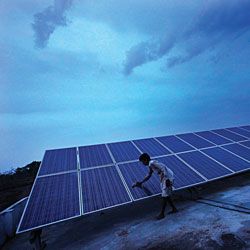
A new kind of company is set to be floated on the Mumbai Stock Exchange in the next year or so, which it is hoped will help wind and solar project developers to secure the vast amounts of capital required to meet India’s ambitious renewable energy targets. The vehicle, called an infrastructure investment trust, or InvIT, is similar in structure to the real estate investment trusts that exist in many other jurisdictions and is designed to allow public equity investors to hold a stake in a portfolio of cashflow generating infrastructure assets.
At the same time it provides developers with a way to monetise their wind and solar projects once construction is complete, freeing up much needed capital to plough back into projects that are in the earlier stages of development.
The listed investment vehicle is not designed solely for renewable energy — the only company so far to file a draft prospectus for an InvIT with the Securities and Exchange Board of India develops toll roads. But renewable project sponsors and their advisers see it as a potentially useful tool, alongside loans, bonds and direct equity investments, in their quest for fresh sources of capital to fuel India’s renewables revolution.
And they will need to tap all the sources of capital they can find if the government’s latest targets for renewable energy installations are to be met.
In a bold move last year prime minister Narendra Modi’s government increased the country’s target for renewable power fivefold. From 20GW of installed capacity by 2022, the target for solar was increased to 100GW in the same timeframe. The 2022 target for installed wind power capacity was set at 60GW.
To put those numbers into perspective, as of July 2016 the total installed solar capacity in the country was just 8.1GW, while wind capacity stood at about 27.4GW, meaning that developers need to install about 15GW to 17GW a year of solar for the next six years and about 5GW a year of wind.
Despite the enormity of the task industry insiders are remarkably confident.
“It’s not a very big ask,” says Vinay Kumar, chief operating officer at Greenko, one of India’s largest renewables focused independent power producers. “It’s a good target and it’s not unrealistic to be hitting 80% to 90% of these targets by the deadline. I’m optimistic.”
But if the renewable power industry in India is to develop and construct the solar and wind projects that will be needed to fill the immense gulf between the existing capacity and the target, it will need to deploy more capital more quickly than ever before.
Greenko and rival renewable IPPs such as ReNew Power and Mytrah Energy have been successful in attracting interest from a wide range of strategic and financial equity investors, from Singapore’s sovereign wealth fund, GIC and German development bank KfW to Goldman Sachs and Merrill Lynch.
“We have raised around $650m of equity and we may need another $400m to $450m at most. So maybe at around $1.1bn we would be fully funded for a business plan of around 9GW to 10GW,” says Kailash Vaswani, deputy chief financial officer at ReNew Power, whose majority shareholder is Goldman Sachs.
In addition to the equity provided by its shareholders, the company will recycle the cashflows from its operating portfolio, which is 1.2GW in size and constantly growing. But by far the largest capital requirement will be in the form of debt — about $270bn for ReNew’s business plan.
BRIDGING THE DEBT GAP
Wind and solar projects are typically financed, in India as in other emerging markets, with a combination of sponsor equity and limited recourse project finance loans.
Interest rates on loans provided by domestic banks in India are high — project finance loans are typically priced between 9.5% and 12% — but while some foreign commercial lenders that could in theory offer more attractive rates, including Deutsche Bank, are said to be looking at entering the space, it takes a lot of work for them to be able to get comfortable with the risks involved.
Foremost among those risks is the financial health of the utility companies that are the main offtakers of power. In India those companies, government-owned and known as distribution companies or “discoms”, have experienced such serious financial difficulties in recent years that the central government has felt the need to step in and restructure their debts.
Indian commercial banks that have a long history of providing project finance are familiar with the risks — which vary from one state and discom to another — and can price the loans accordingly. But for a foreign bank, assessing the ability of the individual discoms to make payments under their power purchase agreements represents a serious amount of credit work, and some market participants question whether the exercise is worth the effort.
“The other trouble is that if you are having external commercial boarding in US dollars, then you need to take the currency risk as well,” notes Pallavi Bedi, a partner in the project finance practice of J. Sagar Associates, a law firm based in New Delhi. “So people were saying if you were doing hedging plus Libor interest rates, you were still coming down to about an 8% or 9% interest rate so it wasn’t making that much financial sense.”
If foreign commercial bank lending to renewables projects proves unfeasible, sponsors will have to rely as they have in the past on the domestic commercial banks, multilateral institutions and export credit agencies.
However, a slowdown in the development of conventional, fossil fuel-burning plants is helping to make more capital available for wind and solar. If there are no opportunities to lend to coal-fired and gas-fired power plant projects, the banks’ structured finance teams will have to put the cash to work elsewhere.
“There has been no real new investment in conventional power plants in the last two or three years,” says L. Viswanathan, a Mumbai-based project finance partner at law firm Cyril Amarchand Mangaldas. “Until existing issues that conventional power plants have around cost recovery have been sorted out, some of the major developers are not going to make any new investment in greenfield conventional power plants and the lenders are also not going to support that, so that adds to the impetus to get the renewable capacity ramped up as well. That is going to be a big contributing factor.”
Another development that will free up capacity in the loan market is the growing trend of IPPs tapping the capital markets.
ReNew Power has issued three bonds in the onshore Indian market replacing more expensive project loans.
Last year it also issued a novel bond for an individual 85MW wind project in the Sangli district of southern Maharashtra state. The bond was supported by a credit enhancement feature whereby the AAA-rated government-owned India Infrastructure Finance Company provided a first loss default guarantee on a portion of the debt.
India Ratings & Research, the Indian affiliate of Fitch Ratings, gave the credit enhanced RP4.5bn bond an IND AA+ rating and the deal attracted the participation of Indian insurers, pension funds and infrastructure debt funds.
“It was an attractive transaction for us,” says ReNew’s Vaswani, who adds that the company is planning to issue two more similar bonds before the end of the year.
Since ReNew only develops renewable energy projects, its bonds have been described as “green” but they weren’t marketed as such, says Vaswani. “Currently in India you are not really getting the benefit of greenness. There are no green dedicated funds in India.”
But that did not put off fellow renewable power producer Hero Future Energies from becoming the first Asian issuer of a climate bond certified by the Climate Bonds Initiative in February with a RP3bn multi-tranche transaction.
The green designation could become more important as the credit ratings of the IPPs improve and if they begin to tap the offshore dollar denominated bond market, although for that to be the case the problem of currency hedging would have to be addressed.
In an effort to do just that, the Indian government is exploring the possibility of auctioning power purchase agreements where the tariff is denominated in dollars rather than rupees and hedging the currency risk itself through a pool of funds that it would set up.
INDIA’S YIELDCOS
In the meantime, market participants are interested to see how investors will react when the first renewable infrastructure investment trust is launched. The Securities and Exchange Board of India has issued guidelines on the vehicles and Mytrah Energy is reportedly among those contemplating a listing.
The description of the proposed renewable InvIT will sound familiar to anyone who has been following the fortunes of the so-called “yield companies” in the US, a comparison which could arouse a degree of caution. The model is essentially the same: roll up cashflow-generating renewable projects into a vehicle listed on an exchange.
The yield companies (yieldcos for short) in the US were initially greeted enthusiastically by investors but the companies’ share prices dropped precipitously in 2015 amid falling oil and gas prices and a loss of faith in the ability of some of the companies to execute a pipeline of increasingly bold acquisitions.
Since then, the Missouri-based renewable energy developer behind two of the yieldcos, SunEdison, has filed for bankruptcy and is now seeking to sell its entire global project portfolio.
Power producers in India and their advisers are well aware of the case, not least because SunEdison had a portfolio of projects totalling about 1.2GW in the country. Several players are making bids for them.
“I think the experience which investors had with the yieldcos… I don’t think we need to follow the same track here,” says Kumar.


